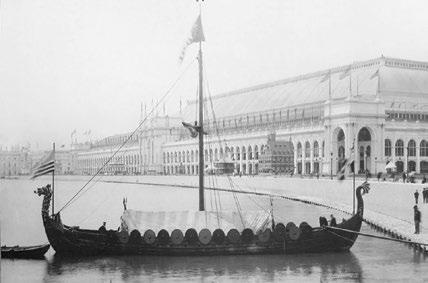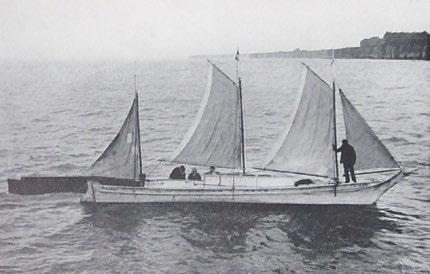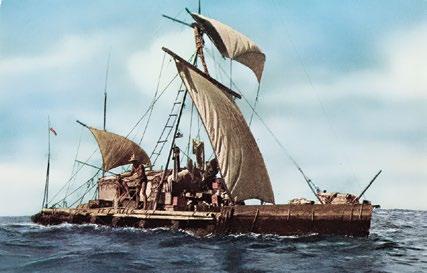
4 minute read
Historic Vessels
from Wavelength #72
Viking
The discovery of Gokstad, a ninth-century Viking ship, prompted the construction of a replica with the aim of showing that European visitors could have reached America well before Colombus did. More specifically, a 78ft (24m) long 17ft (5.2m) wide vessel to be called Viking was built at Rødsvernen ship yard in Sandefjord to lend weight to the theory of Lief Ericsson having discovered the New World. What is more, Viking’s voyage was timed to coincide with the commemoration of the discovery of America by Columbus at the World’s Columbian Exposition in Chicago in 1893. Under the command of Captain Magnus Andersen, whose crew was from Bergen, Viking sailed up the Norwegian coast before crossing to America. The dramatic voyage saw the ship
Advertisement
being lifted clear of the waves on several occasions. After reaching Newfoundland, Andersen sailed up the Hudson River, and then on to Chicago via the Erie Canal and the Great Lakes. On the day Viking reached the windy city, attendance at the Exposition doubled. Following a successful appearance in Chicago, Viking sailed to New Orleans, where she spent a winter. In 1920, back in Chicago restoration work was carried out. The Viking at the World's Columbian Exposition in Chicago, 1893. Source: www.wikipedia.org However, there followed a long period of neglect. Fortunately, a non-profit organisation called Friends of the Viking Ship has stepped in and now Viking stands at Good Templar Park in Illinois with a brighter future. Sources: www.vikingship.us, www.oldsaltblog.com
Tilikum
In 1901, John Voss purchased a 38-foot red cedar Nootkan war canoe for $80 worth of silver. Together with his partner, Norman Luxton, in their proposed maritime venture, Voss had the dugout converted into a schooner with 230sq ft (21m2) of sail. Once the conversion had been completed, Captain Voss left Oak Bay harbour in British Columbia with Luxton and his crew bound for the Indian Ocean via Australia. After five months at sea, Tilikum hit a reef and Norman Luxton was thrown overboard. Although he suffered lacerations, he was able to resume his duties as master until Suva, Fiji, where he was forced to leave the expedition. On the next leg of the voyage to Australia, the
binnacle and compass were lost, leaving Voss to navigate by ancient methods. Tilikum arrived in Melbourne on 13th March 1902. With the help of Australian yachtsmen, Voss made repairs and fitted new sails so as to be able to reach England. In September 1904, Tilikum beached in the River Thames. The converted schooner changed hands several times in Tilikum at Margate with Captain John Voss standing the English capital prior to being taken to at the bow. Source: en.wikipedia.org Victoria, British Columbia, where she was restored in 1936. Today, Tilikum can be seen at the Ogden Point cruise ship terminal in Victoria BC. Source: en.wikipedia.org

Kon-Tiki
While doing research in the Marquesas Islands in 1937, Thor Heyerdal developed an ethnological theory that the first settlers in Polynesia came from pre-Incan Peru via Easter Island on rafts around 500 AD. Although such a voyage was deemed impossible, Heyerdal was spurred on to test his theory by both his belief in it and the inspiration he got from the voyages of Viking and Tilikum. Heyerdal’s raft comprised 9 balsawood logs lashed together with hemp ropes and a bamboo cabin covered with banana leaves. The 30ft x 15 (9m x 4.5m) craft was christened Kon-Tiki after the Peruvian sun god prior to leaving Callao on 25th April 1947 with six men and a talking green parrot aboard. The relatively large sail helped trade winds push the raft across the water. A sail paddle and steering oar allowed the crew to manoeuvre the craft through waves that often dwarfed the small vessel, while the sun, stars, currents and winds provided navigational data. As for food, flying fish that landed on the
deck together with other species of fish attracted by the seaweed and shellfish growing under Kon-Tiki provided most of the sustenance required. However, not all fish were welcome as visitors like the great white sharks that caused the crew to become extremely anxious. On the 93rd day, palm trees were sighted but the prevailing winds and currents made it impossible to reach land. A week Expedition across the Pacific 1947 later, a reef was spotted, but the weather Sources: www.kon-tiki.no, www.history.com, www.youtube.com caused chaos, snapping the mast and forcing the crew to hold on for dear life. Eventually, after 101 days at sea, Kon-Tiki arrived at Roroia atoll in the Tuamoto Archipelago near Tahiti, 4300 miles from Callao. Just as Thor Heyerdal had been inspired by earlier voyages, he inspired others to replicate his voyage, which was recorded in a best-selling book and two films shot in 1951 and 2012. Today, the world famous raft is on display at the Kon-Tiki Musuem in Oslo. Sources: www.kon-tiki.no, www.history.com, www.youtube.com





